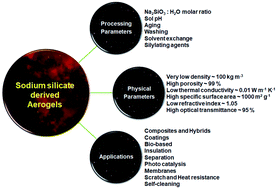Sodium silicate-derived aerogels: effect of processing parameters on their applications
Abstract
Inorganic silica aerogels derived from sodium silicate are voluminous three-dimensional open networks with exceptional properties such as a density as low as ∼100 kg m−3, high porosity (∼99%), low thermal conductivity (∼0.01 W m−1 K−1), high specific surface area (∼1000 m2 g−1), low refractive index (∼1.05) and high optical transmittance (∼95%) depending on their preparation conditions. They are processed through the sol–gel route, which is a reliable methodology to produce high-grade porous materials. Ambient pressure drying has been developed as a low-cost route for the preparation of sodium silicate-derived aerogels, overcoming the difficulties with the use of organosilane precursors and super critical drying. Silica aerogels can be hydrophobic or hydrophilic depending on their synthetic procedure and surface silanol groups. Owing to their unusual properties, these inorganic aerogels have been applied in both commercial and high-tech engineering applications such as thermal insulation, separation, coatings, optics, nuclear particle detection, sensing, and catalysis. This review provides information on the unique features of a wide array of silica aerogels and their potential applications and recent developments in the field of science and technology.

- This article is part of the themed collection: 2021 Reviews in RSC Advances


 Please wait while we load your content...
Please wait while we load your content...